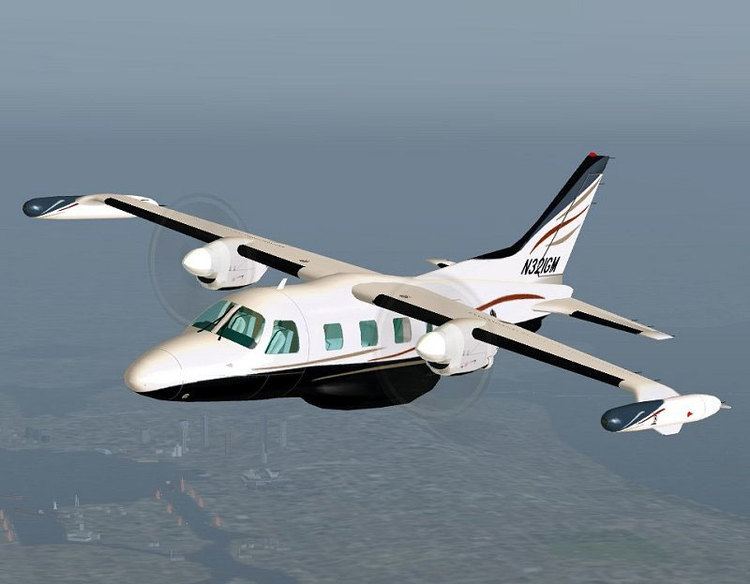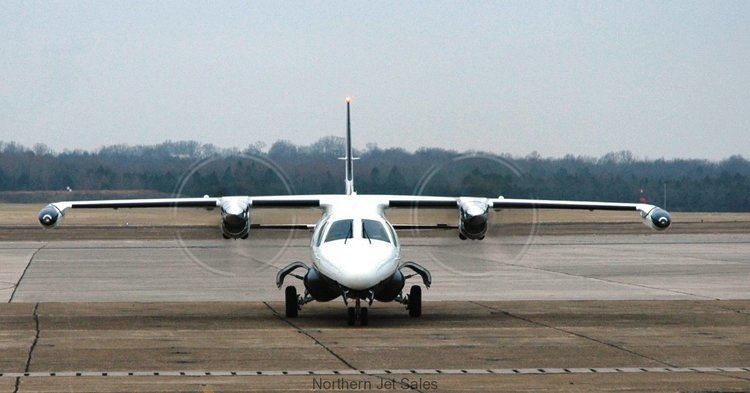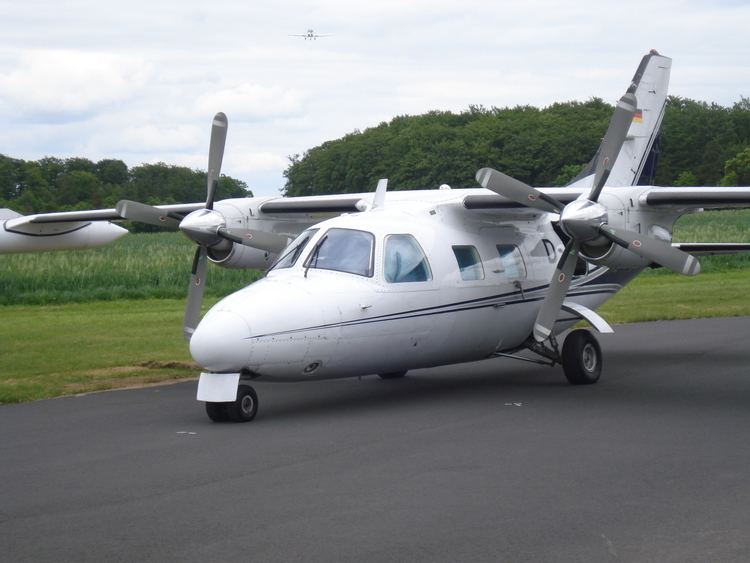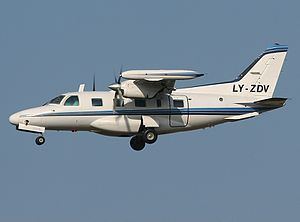Wingspan 12 m Engine type Turboprop | Length 12 m | |
 | ||
Manufacturer | ||
Mitsubishi mu 2 spartan 7w executive
The Mitsubishi MU-2 is a Japanese high-wing, twin-engine turboprop aircraft with a pressurized cabin manufactured by Mitsubishi Heavy Industries. It made its maiden flight in September 1963 and was produced until 1986. It is one of postwar Japan's most successful aircraft, with 704 manufactured in Japan and San Angelo, Texas in the United States.
Contents
- Mitsubishi mu 2 spartan 7w executive
- Mitsubishi mu 2 marquise landing on a short grass runway
- Design and development
- Production
- Japan
- New Zealand
- United States
- Flight around the world
- Safety concerns
- Short fuselage
- Long fuselage
- Military
- Aircraft on display
- Incidents and accidents
- Specifications MU 2L
- References

Mitsubishi mu 2 marquise landing on a short grass runway
Design and development

Work on the MU-2, Mitsubishi's first postwar aircraft design, began in 1956. Designed as a light twin turboprop transport suitable for a variety of civil and military roles, the MU-2 first flew on 14 September 1963. This first MU-2, and the three MU-2As built, were powered by the Turbomeca Astazou turboprop.

Civil MU-2s powered by Garrett engines were certified as variants of the MU-2B, using the MU-2B type followed by a number. For marketing purposes, each variant was given a suffix letter; the MU-2B-10, for example, was sold as the MU-2D, while the MU-2B-36A was marketed as the MU-2N.
Production

In 1963 Mitsubishi granted Mooney Aircraft rights in North America to assemble, sell and support the MU-2. In 1965, Mooney established a facility to assemble MU-2s at its new factory in San Angelo, Texas. Major components were shipped from Japan, and the San Angelo factory installed engines, avionics and interiors then painted, flight tested and delivered the completed aircraft to customers. By 1969 Mooney was in financial difficulty, and the San Angelo facility was taken over by Mitsubishi. Production in the United States ended in 1986. The last Japanese-built aircraft was completed in January 1987.
The subsequent production aircraft, designated MU-2B, were delivered with the Garrett TPE331 engines that remained standard on all later models. Thirty-four MU-2Bs were built, followed by 18 examples of the similar MU-2D. The Japanese armed forces purchased four unpressurized MU-2Cs and 16 search and rescue variants designated MU-2E. Featuring slightly more powerful upgraded TPE331 engines, 95 examples of the MU-2F were sold.
The fuselage was stretched beginning with the MU-2G. The MU-2M (only 28 built) is regarded as the toughest and most desired of all short body MU-2s, especially with a −10 engine conversion. It had a short fuselage and the same engines as the MU-2K and stretched MU-2J and had an increase in cabin pressurization to 6.0 psi; it was followed by the MU-2P, which had newer four-blade propellers. The final short-fuselage MU-2s produced were known as the Solitaire and were fitted with 496 kW (665 shp) Garret TPE331-10-501M engines.
The first significant change to the airframe came with the stretched MU-2G, first flying 10 January 1969, which featured a 1.91 m (6 ft 3 in) longer fuselage than earlier models; 46 were built before being succeeded by the more powerful MU-2J (108 constructed). The MU-2L (29 built) was a higher-gross-weight variant, followed by the MU-2N (39 built) with uprated engines and four-blade propellers. The final stretched-fuselage MU-2 was named the Marquise, and like the Solitaire used 533 kW (715 shp) TPE331 engines.
As of 2005, 397 MU-2 aircraft are registered in the United States.
Japan
The Japanese Self-Defense Forces are the only military operators to have flown the MU-2 in front-line service.
Ground Self-Defense Force
The four C-model aircraft built, in addition to 16 MU-2Ks, entered service with the Japan Ground Self-Defense Force (JGSDF) with the designation LR-1; they were used as liaison and photo reconnaissance aircraft. They were retired in 2016. A number of them have been placed as gate guardians at JGSDF bases.
Air Self-Defense Force
29 MU-2Es were purchased by the Japan Air Self-Defense Force as search-and-rescue aircraft and designated MU-2S. Additional equipment consisted of a "thimble" nose radome, increased fuel capacity, bulged observation windows, and a sliding door for dropping rafts. They were replaced in 2008 by the U-125A. Some have been preserved.
New Zealand
In late 2009 the Royal New Zealand Air Force (RNZAF) took delivery of four Mitsubishi MU-2F fixed-wing training aircraft from the United States for use as training aids. In New Zealand service they are known as the Mitsubishi MU-2 Sumo. The aircraft were ferried to New Zealand and are located at the RNZAF's Ground Training Wing (GTW) at RNZAF Base Woodbourne near Blenheim in New Zealand's South Island.
United States
Since 1987 MU-2s have been flown by retired US Air Force pilots working for Air 1st Aviation Companies, Inc under government contract at Tyndall Air Force Base, Florida, where they provide U.S. Air Force undergraduate Air Battle Manager students of the U.S. Air Force Weapons Controller School with their initial experience controlling live aircraft. In the tactical simulations the aircraft usually represent F-15s and Mikoyan MiG-29s. Students must control eight MU-2 missions before they can progress to controlling high-performance aircraft such as F-15s or F-22s.
Flight around the world
On 25 August 2013 Mike Laver, owner and pilot of N50ET (a −10 engine converted 1974 K-model equipped with 5-blade MT-composite propellers, which had just received an STC under Air 1st of Aiken, SC), along with AOPA Pilot technical editor Mike Collins, embarked on an around-the-world journey in the MU-2B-25. The voyage commenced at Aiken Municipal Airport and sojourned in Nagoya, Japan on 14 September 2013; the 50th anniversary of the MU-2.
Safety concerns
Concerns have been raised about safety in operating the aircraft; there have been 337 fatalities from MU-2 crashes. As of October 2005, the United States Federal Aviation Administration (FAA) undertook a safety evaluation of the aircraft. It concluded that the aircraft has met its certification requirements: it is safe when operated by properly trained pilots who operate properly maintained aircraft. The FAA is in the process of mandating training specific to the MU-2, as it has in the past for other aircraft. When such mandated training was required outside of the U.S., the MU-2 accident record was vastly improved.
Because the MU-2 offers very high performance at a relatively low cost, some of its operators lack sufficient training and experience for such an advanced aircraft. The MU-2 has performance similar to a small jet, yet early pilot licensing required only a simple endorsement from licenses for much slower twin piston-engined aircraft. The fact that numerous MU-2 pilots were inexperienced at high speeds and high altitudes seems to have resulted in the high crash rate. Once a type certification was required for an MU-2 license, the accident rate dropped to normal levels.
A design feature of the MU-2 is its high cruise speed, while having a low landing speed. This is accomplished by using full-span, double-slotted flaps on the trailing edge of the wing. These flaps give the MU-2 a wing area comparable to a Beech King Air in landing configuration, while having a wing area comparable to a light jet while in cruise mode. The full-span flaps meant that over-wing spoilers were employed instead of conventional ailerons.
These spoilers are highly effective, even when the MU-2 wing is stalled. Some fatal accidents have occurred because normal engine-out procedures for light twin aircraft are not effective when flying the MU-2. The commonly taught procedure of reducing flap following an engine failure on take off leads to a critical reduction in lift in the MU-2 due to the highly effective double-slotted flaps. When pilots were taught to retain take-off flap and to reduce climb rate in the event of an engine failure, MU-2 accident rates were reduced to almost nil.
From an FAA press release:
The FAA began an aggressive safety evaluation in July 2005. The evaluation is performing a detailed review of accidents, incidents, airworthiness directives, service difficulty reports, safety recommendations and safety reports. It also is examining pilot training requirements, the history of the aircraft's commercial operators and possible engine problems. The goal is to identify the root causes of MU-2 accidents and incidents and determine what, if any, additional safety actions are needed.In early 2008, the FAA issued a Special Federal Air Regulation (SFAR) directed at MU-2B operations. Pilots flying this aircraft after that date (current MU-2 pilots would have a year to come into compliance) were required to receive type-specific initial training, as well as recurrent training. The agency also required that a fully functional autopilot be available for single-pilot operations, and that FAA-approved checklists and operating manuals be on board at all times. Unusually for this SFAR, pilot experience in other aircraft types cannot be used to comply with MU-2 operational requirements. For instance, the requirement to perform landings within the preceding 90 calendar days before carrying passengers is altered by this SFAR to require those landings be made in the MU-2.
As of 29 March 2016, there have been three fatal accidents involving the MU-2 since the FAA SFAR (Title 14; Part 91, SFAR Number 108) was implemented beginning in 2008.
Short fuselage
Long fuselage
Military
Aircraft on display
Incidents and accidents
Specifications (MU-2L)
Data from Jane's All The World's Aircraft 1976–77
General characteristics
Performance
